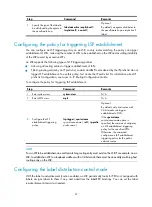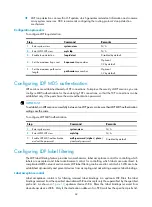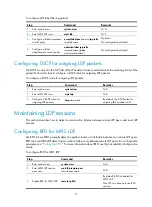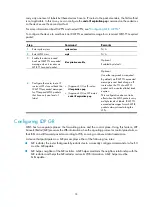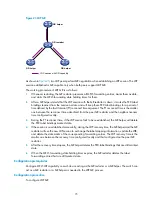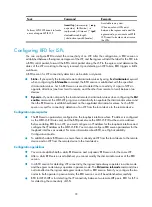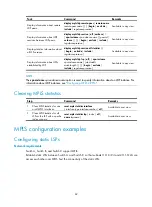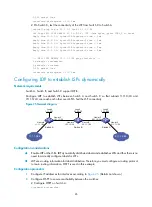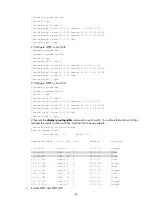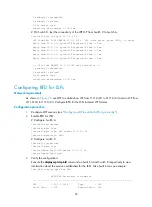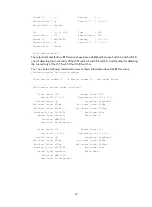
78
Task Command
Remarks
Perform MPLS LSP tracert to locate
errors along an MPLS LSP.
tracert lsp
[
-a
source-ip
|
-exp
exp-value
|
-h
ttl-value
|
-r
reply-mode
|
-t
time-out
]
*
ipv4
dest-addr mask-length
[
destination-ip-addr-header
]
Available in any view.
When equal-cost LSPs exist
between the ingress node and the
egress mode, you cannot use MPLS
LSP tracert to locate node errors on
the LSPs.
Configuring BFD for LSPs
You can configure BFD to detect the connectivity of an LSP. After the configuration, a BFD session is
established between the ingress and egress of the LSP, and the ingress will add the label for the FEC into
a BFD control packet, forward the BFD control packet along the LSP to the egress, and determine the
status of the LSP according to the reply received. Upon detecting an LSP failure, BFD triggers a traffic
switchover.
A BFD session for LSP connectivity detection can be static or dynamic.
•
Static
—If you specify the local and remote discriminator values by using the
discriminator
keyword
when configuring the
bfd enable
command, the BFD session is established with the specified
discriminator values. Such a BFD session is used to detect the connectivity of a pair of LSPs in
opposite directions (one from local to remote, and the other from remote to local) between two
devices.
•
Dynamic
—If you do not specify the local and remote discriminator values when configuring the
bfd
enable
command, the MPLS LSP ping is run automatically to negotiate the discriminator values and
then the BFD session is established based on the negotiated discriminator values. Such a BFD
session is used for connectivity detection of an LSP from the local device to the remote device.
Configuration prerequisites
•
The BFD session parameters configured on the loopback interface whose IP address is configured
as the MPLS LSR ID are used, and the BFD packets use the MPLS LSR ID as the source address.
Before enabling BFD for an LSP, you must configure an IP address for the loopback interface and
configure the IP address as the MPLS LSR ID. You can also configure BFD session parameters for the
loopback interface as needed. For more information about BFD, see
High Availability
Configuration Guide
.
•
To establish a static BFD session, ensure there is already an LSP from the local device to the remote
device and an LSP from the remote device to the local device.
Configuration guidelines
•
You cannot establish both a static BFD session and a dynamic BFD session for the same LSP.
•
After a static BFD session is established, you cannot modify the discriminator values of the BFD
session.
•
In a BFD session for detecting LSP connectivity, the ingress node always operates in active mode
and the egress node always operates in passive mode. The
bfd session init-mode
command does
not take effect on the ingress and egress nodes of such a BFD session. Even if you configure the two
nodes to both operate in passive mode, the BFD session can still be established successfully.
•
BFD for MPLS LDP is for detecting the IP connectivity between two remote LDP peers. BFD for LSP is
for detecting the connectivity of LSPs.




